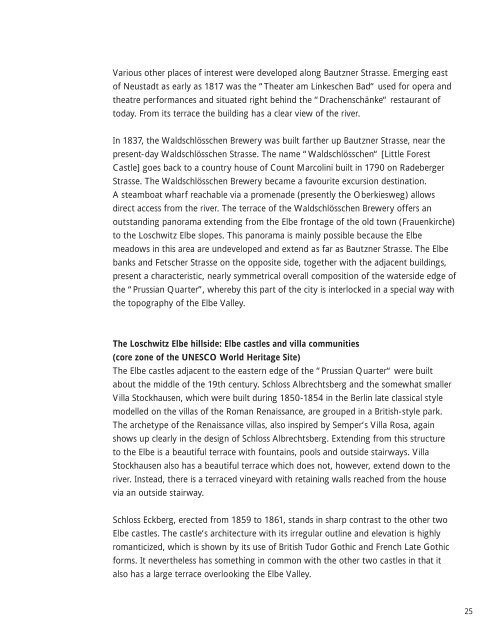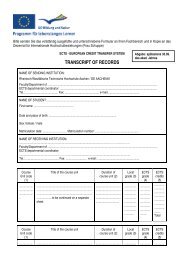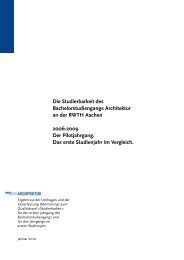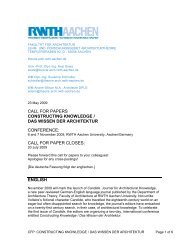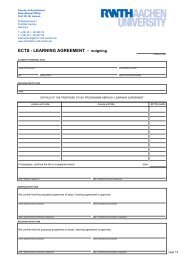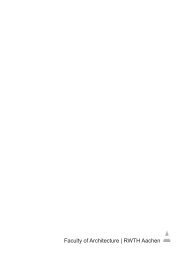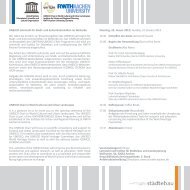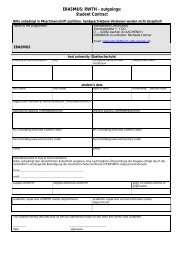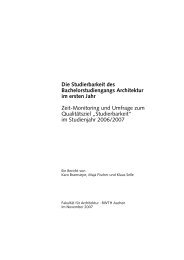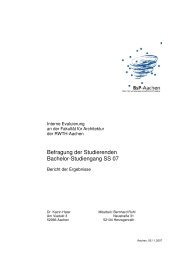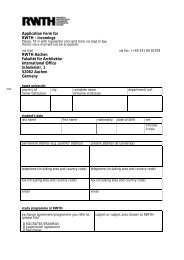Gutachten Dresden_englisch_dritte f.indd - Fakultät für Architektur ...
Gutachten Dresden_englisch_dritte f.indd - Fakultät für Architektur ...
Gutachten Dresden_englisch_dritte f.indd - Fakultät für Architektur ...
You also want an ePaper? Increase the reach of your titles
YUMPU automatically turns print PDFs into web optimized ePapers that Google loves.
Various other places of interest were developed along Bautzner Strasse. Emerging east<br />
of Neustadt as early as 1817 was the “Theater am Linkeschen Bad“ used for opera and<br />
theatre performances and situated right behind the “Drachenschänke“ restaurant of<br />
today. From its terrace the building has a clear view of the river.<br />
In 1837, the Waldschlösschen Brewery was built farther up Bautzner Strasse, near the<br />
present-day Waldschlösschen Strasse. The name “Waldschlösschen“ [Little Forest<br />
Castle] goes back to a country house of Count Marcolini built in 1790 on Radeberger<br />
Strasse. The Waldschlösschen Brewery became a favourite excursion destination.<br />
A steamboat wharf reachable via a promenade (presently the Oberkiesweg) allows<br />
direct access from the river. The terrace of the Waldschlösschen Brewery offers an<br />
outstanding panorama extending from the Elbe frontage of the old town (Frauenkirche)<br />
to the Loschwitz Elbe slopes. This panorama is mainly possible because the Elbe<br />
meadows in this area are undeveloped and extend as far as Bautzner Strasse. The Elbe<br />
banks and Fetscher Strasse on the opposite side, together with the adjacent buildings,<br />
present a characteristic, nearly symmetrical overall composition of the waterside edge of<br />
the “Prussian Quarter”, whereby this part of the city is interlocked in a special way with<br />
the topography of the Elbe Valley.<br />
The Loschwitz Elbe hillside: Elbe castles and villa communities<br />
(core zone of the UNESCO World Heritage Site)<br />
The Elbe castles adjacent to the eastern edge of the “Prussian Quarter“ were built<br />
about the middle of the 19th century. Schloss Albrechtsberg and the somewhat smaller<br />
Villa Stockhausen, which were built during 1850-1854 in the Berlin late classical style<br />
modelled on the villas of the Roman Renaissance, are grouped in a British-style park.<br />
The archetype of the Renaissance villas, also inspired by Semper‘s Villa Rosa, again<br />
shows up clearly in the design of Schloss Albrechtsberg. Extending from this structure<br />
to the Elbe is a beautiful terrace with fountains, pools and outside stairways. Villa<br />
Stockhausen also has a beautiful terrace which does not, however, extend down to the<br />
river. Instead, there is a terraced vineyard with retaining walls reached from the house<br />
via an outside stairway.<br />
Schloss Eckberg, erected from 1859 to 1861, stands in sharp contrast to the other two<br />
Elbe castles. The castle‘s architecture with its irregular outline and elevation is highly<br />
romanticized, which is shown by its use of British Tudor Gothic and French Late Gothic<br />
forms. It nevertheless has something in common with the other two castles in that it<br />
also has a large terrace overlooking the Elbe Valley.<br />
25


